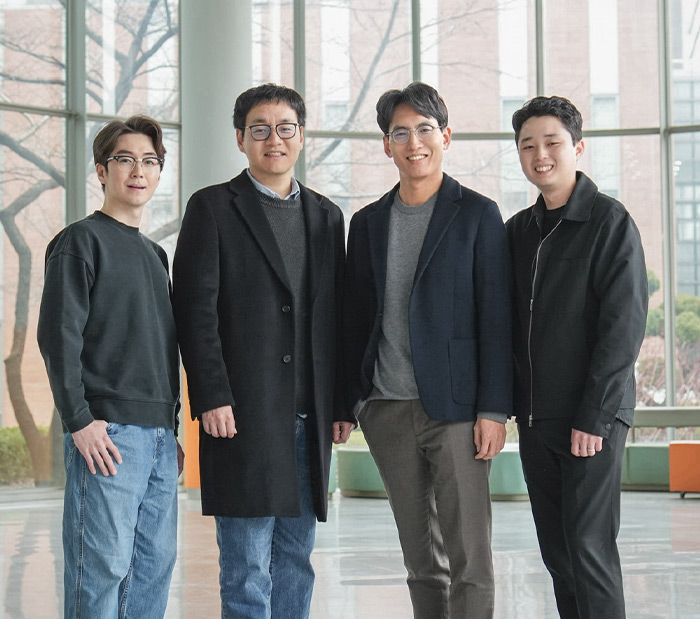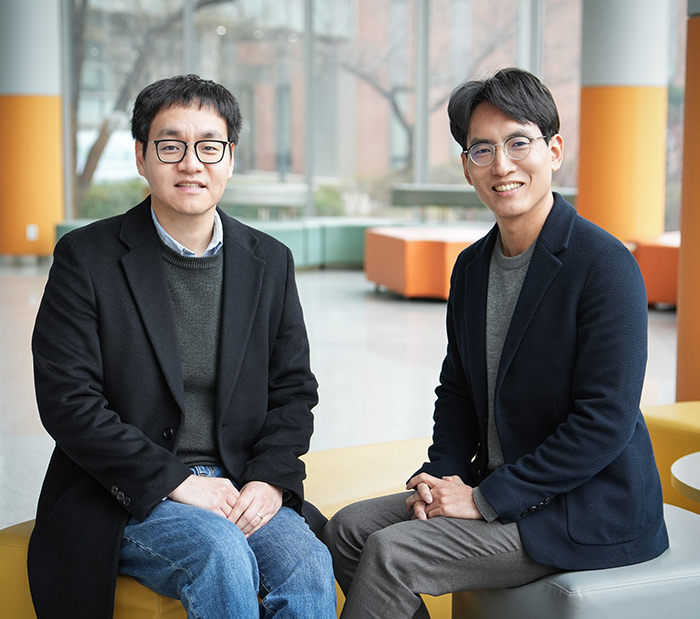Development of two novel methodologies for efficient representation of complex 3D scenes
전자전기/인공지능학과 박은병, 고종환 Prof. · Prof. Eunbyung Park and Prof. Jong Hwan Ko
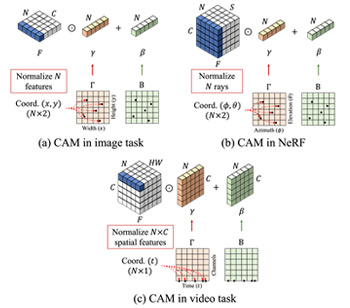
-
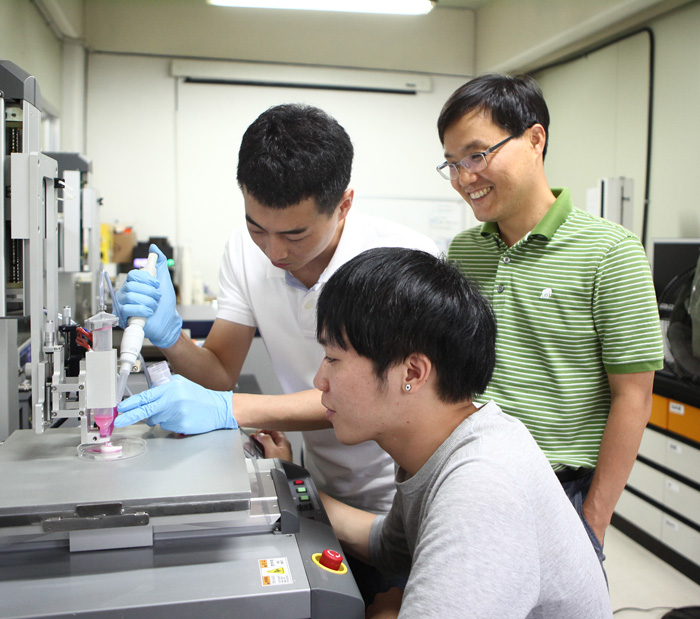
Bio-Mechatronic Engineering KIM, GEUNHYUNG Prof.
Fabrication of Artificial Tissues & Organs Using Extrusion-based Cell Printing Technique
A research team led by Prof. Geun Hyung KIM of the Department of BioMechatronic Engineering proposed the world’s first hybrid cell-printing technique that combines a conventional extrusion-based cell-printing process with an electrohydrodynamic jet. The electric field stabilized the extruded struts of cell-embedding-hydrogel and reduced the damage to dispensed cells caused by the high wall shear stress in the dispensing nozzle. The new cellprinting process was optimized in terms of various processing parameters, applied electric field strength, nozzle movement speed, and distance between the nozzle tip and working stage. Because of these unique features, scholars in the field and cell-printing companies show their interest to learn more about this technique. 그림 2에서와 같이 유리판을 사용하지 않았을 때 전류가 0.05~0.6A였지만 세라믹코팅을 이용하면 10~35nA까지 내려가는 것으로 나타났다. 이를 통해 전기장을 사용한 세포-프린팅 기술이 바이오잉크의 종류에 상관없이 안전하게 사용 가능하다는 것이 확인되었다. 이러한 방법은 물리적 반응 및 주위 환경조건에 민감한 줄기세포를 안정적이고 원활하게 압출될 수 있도록 컨트롤 가능하며, 노즐 벽면에서의 전단응력을 최소화 하여 세포의 생존율을 90% 이상 유지 시켜줄 수 있게 하였다. 또한, 개발된 세포프린팅 기술을 이용하면 기존의 세포프린팅 방식에 비해 단시간에 마이크로크기의 strut으로 이루어진 미세 다공성의 3D 세포구조체를 제작 할 수 있으며 (그림 3), 이 기술은 기존의 조직공학에서 사용되는 세포프린팅 기술을 한 단계 업그레이드 시킨 기술로서, 향후 다양한 조직 재생 (피부, 연골, 근육, 뼈 및 간등)에 적용이 가능할 것으로 생각된다. 이러한 결과는 생체소재/가공 분야의 전문학술지인 “Acta Biomaterialia”에 게재 되었다. 조직재생/바이오가공연구실 성균관대학교 생명공학대학 바이오메카트로닉스학과 조직재생/바이오가공연구실은 김근형 교수의 지도하에 박사 후 연구원 1명, 박사과정 3명, 석박통합 5명, 학부연구생 4명이 열심히 연구하고 있다. 주로 인체주요 조직인 연골, 피부, 근육 및 간 등 다양한 장기재생용 구조체를 제작할 수 있는 공정 시스템개발 및 이를 이용한 3D 세포구조체 제작에 관한 연구를 수행하고 있다. 특히, 3D 프린팅을 기반으로 하여 전기유체공정, 플라즈마프로세스, 마이크로/나노 임프린팅 등 다양한 공정을 결합하여 신개념의 세포조직재생 공정을 개발하고 있으며, 이를 이용하여 세포구조체 형상 제작 및 다양한 표면 개질을 통해 세포의 성장 및 분화를 촉진 시킬 수 있는 연구를 수행 중이다. 본 연구실에서는 기계공학/전기-전자공학/재료공학/의-약학이 결합된 융합 연구영역을 추구하며, 실제 다양한 학문을 전공한 학생들이 모여서 창의적 융합연구를 수행 중이다. 또한, 코넬대학교, 미국국립표준기술연구소(NIST) 국제협력 연구와 국내 한강성심병원 화상연구센터, 서울대학교병원, 서울대-보라매병원, 한국기계연구원부설-재료연구소 등과 공동연구를 진행중이다.
- No. 7
- 2018-07-05
- 3695
-
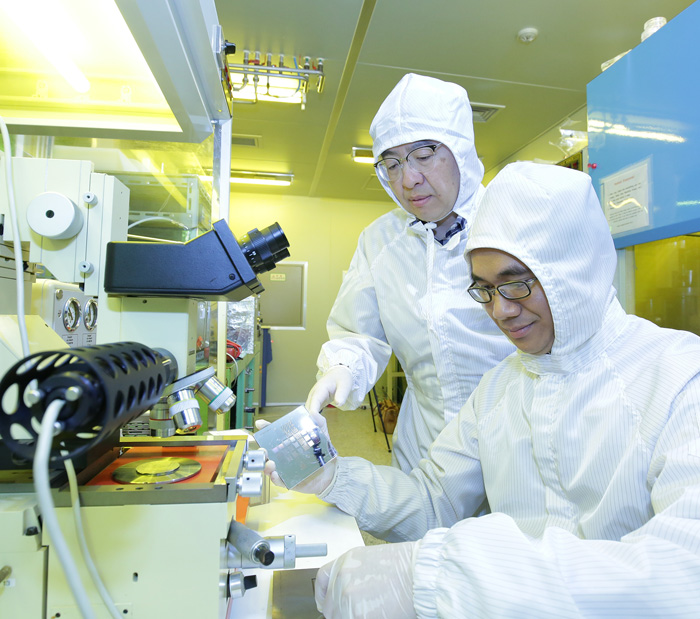
Physics KANG, DAE-JOON Prof.
PMMA-Etching-Free Transfer of Wafer-scale Chemical Vapor Deposition Two-dimensional Atomic Crystal by a Water Soluble Po
Two-dimensional (2D) materials have attracted much attention due to their unique properties and great potential in various applications. Controllable synthesis of 2D materials with high quality and high efficiency is essential for their large scale device applications. Chemical vapor deposition (CVD) has been one of the most reliable technique for the synthesis of 2D materials. To explore novel applications and the discovery of new phenomena in these materials, it is necessary to develop a process to transfer high quality and large area 2D materials onto desirable substrates with great efficiency and high yield. The research team led by Prof. KANG demonstrate that adding a water soluble PVA layer inbetween the PMMA layer and 2D material grown on a rigid substrate allows not only the effective transfer to arbitrary target substrates with a high degree of freedom but also avoids the etching of the PMMA layer to obtain contaminationfree high quality 2D materials by avoiding detrimental effects related to surface contaminants. Graphene transferred by this process exhibits excellent quality, indicated by a charge neutrality point being close to zero. Due to the elimination of contamination from the PMMA residues, both graphene and MoS2 FETs fabricated using their transfer method showed higher mobility and current modulation values compared to those formed using conventional PMMA assisted transfer of the 2D materials. This facile transfer technique has great potential for future research towards the application of 2D materials in high performance optical, mechanical, and electronic devices.
- No. 6
- 2018-07-05
- 2285
-
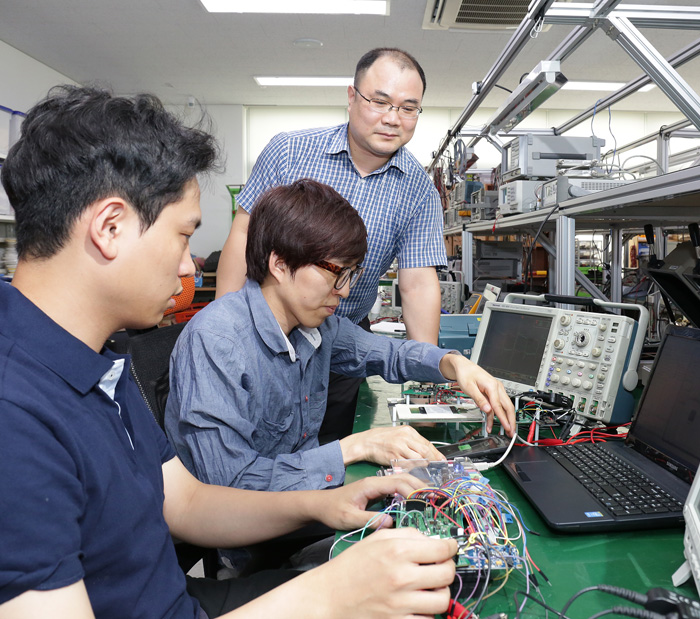
Electronic and Electrical Engineering LEE, KANG YOON Prof.
Prof. Kang Yoon Lee Received the Award of ‘2016 Top 100 R&D Performance in Korea’
Prof. Kang Yoon LEE, School of Electronic and Electrical Engineering at SKKU, received the award of ‘2016 Top 100 R&D Performance in Korea’, with the study of a fast wireless charging Integrated Circuit (IC) that can be applied to triple international standard modes (A4WP, WPC, PMA). On July 7th (Thurs), The Ministry of Science, ICT, and Future Planning selected the Top 100 researches that have shown great results and awarded them. Also for those projects that were recognized as excellent, the government prepared an exhibit room and introduced researches briefly to the public. Since 2006, the Korean government has chosen a hundred outstanding research projects to raise the self-esteem of scientists and to promote the successful researches of the country. This year, 54,000 research projects were completed under the government’s funds and 620 were on the list of recommendation. Among the nominees, experts of research and business industries selected a hundred researches based on the impact to the country and possibility of positively affecting economics. Prof. LEE said “from this award, we proved SKKU’s great research abilities and I will continue focusing on research and education.”
- No. 5
- 2018-07-05
- 2476
-
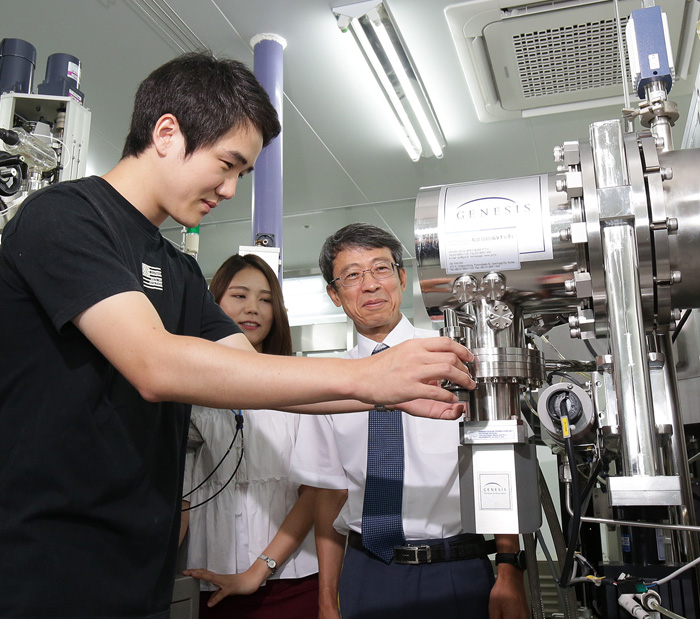
Electronic and Electrical Engineering CHOI, BYOUNG DEOG Prof.
World’s First Technology to Analyze and Visualize a Solar Battery in 3D
A research team of the College of Information and Communication Engineering at SKKU discovered an energy defect in CulnGaSeS structure of a solar battery and three-dimensionally (3D) visualized the defect in shape and distribution. There have been many studies on the impact of the defect on solar batteries and its efficiency, but it was not easy to investigate due to the lack of measurement methods. This research provides a fascinating route to discover distinct types of defects (acceptor or donor) that can affect the efficiency of solar batteries, by analyzing microdefects quantitatively with DLTS methods and visualizing with various depths in the stage of absorption. Prof. CHOI explains that “This technology will contribute to an increase in reliability and to improve the life cycle of cells related to semiconductor memory, solar batteries, and display.” The study was led by Sung HUR, Ph.D., and Prof. Byoung Deog CHOI from the College of Information and Communication Engineering in SKKU, and Dong Ho LEE, Ph.D., from Samsung SDS, while Prof. Hun Young CHOI from Dongguk University and Prof. Hee Jae KANG from Chungbuk National University also participated. The main title of the research is “Defect Visualization of Cu(InGa)(SeS)2 Thin films using DLTS Measurements” and it was published in the Science Report August edition. 최병덕 교수
- No. 4
- 2018-07-05
- 1900
-
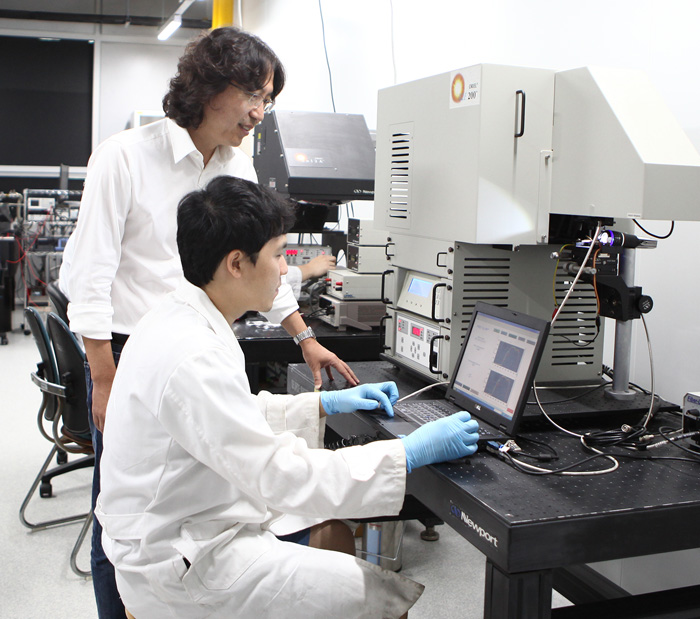
Energy Science SHIN, HYUN JUNG Prof.
Next generation perovskite solar cell with improved the efficiency and stability by utilizing the nickel oxide ultrathin
Researchers recently have focused on organic-inorganic hybrid perovskite materials that would allow low-cost and highly efficient photovoltaic since the power conversion efficiency (PCE) of this cell has rapidly increased from 2.2 % in 2008 to 22% in 2016. The device architecture is composed of electrodes, perovskite photo-active layer with charge transport layers as an interlayer. Although organic hole transport layers are usually used for hole extraction, it is very vulnerable to heat, light, and moisture. Alternatively, the researchers developed perovskite solar cells using inorganic NiO as HTL grown via atomic layer deposition (ALD). The team synthesized ultra-thin (~ 5 nm) NiO films having high transmittance as well as low series resistance, finally demonstrated stable and efficient perovskite solar cells. Researchers also studied to deposit highly dense electron transport layers (ETL) using ALD on top of perovskite in order to improve the stability of the perovskite solar cells. The highly dense ALD-ETL protects moisture transmission from outside greatly and also suppresses decomposition of perovskite from inside. They demonstrated highly stable perovskite solar cells using ALD-ETL without further encapsulation technique and performance loss. This work was published in the journals; Nanoscale (2016) and Nat. Energy (2016).
- No. 3
- 2018-07-05
- 2453
-
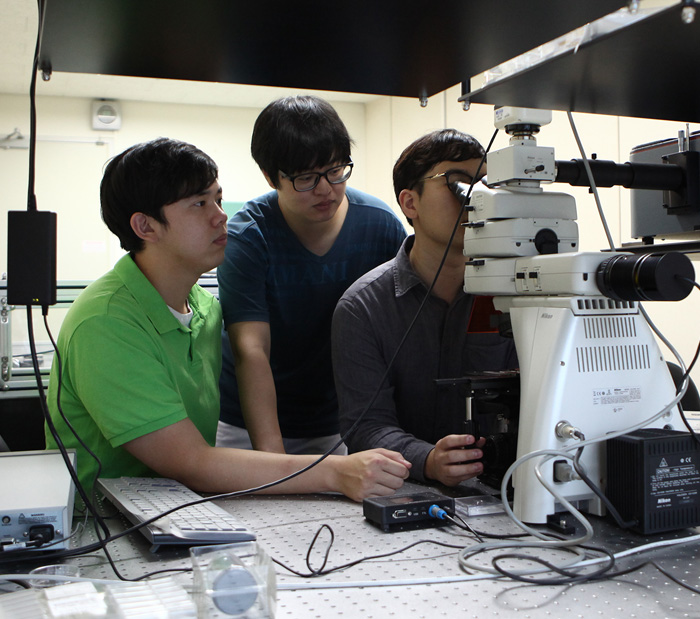
SKKU Advanced Institute of Nano Technology LEE, SEUNGWOO Prof.
Generating Metamaterial, Inspired by the Motion Control of an Aphid’s Leg
Generating Metamaterial, inspired by the motion control of an Aphid’s leg Metamaterials have made the exotic control of the flow of electromagnetic waves possible, which is difficult to achieve with natural materials. In recent years, the emergence of functional metadevices has shown immense potential for the practical realization of highly efficient photonic devices. However, complex and heterogeneous architectures that enable diverse functionalities of metamaterials and metadevices, have been challenging to realize because of the limited manufacturing capabilities of conventional fabrication methods. In this research, it was discovered that three-dimensional (3D) modular transfer printing can be used to construct diverse metamaterials in complex 3D architectures on universal substrates, which is attractive for achieving on-demand photonic properties. This study is inspired by Dry-adhesion Control of the leg of an Aphid, which climbs walls without sticky materials and moves upside down on plant stems. By Dry-adhesion Control, Aphids can regulate the attractive force between leg and object without any restriction. As described in picture 1, the surface area of the leg that is touching the object can be maximized or minimized, depending on the blood pressure of the back of the leg. In this research, a rubber stamp is designed and made to work in a similar manner with that of this insects’ leg motion. As seen picture 2, the rubber stamp with a sharp end can print anything easily due to a minimized surface area (adhesion-off) between metamaterials and the rubber stamp. Metamaterial can be removed from the maximized surface area (adhesion-on) if the sharp end crumbles. This method provides a fascinating route to generate flexible and stretchable 2D/3D metamaterials and metadevices with heterogeneous material components, complex device architectures, and diverse functionalities. About Research Laboratory of Biomimetic & Photonic Properties The Research Laboratory of Biomimetic & Photonic Properties was established in 2014 as a part of SKKU Advanced Institute of Nanotechnology (SAINT). Prof. SeungWoo Lee and 7 students of undergraduate and graduate levels are researching biomimetic by using ductile nanomaterial such as DNA origami/ polymers to create various light-material interactions and more. The laboratory is pursuing the convergence of various academic knowledges, including chemical engineering, physics, electrical engineering, and chemistry. We participate in the competition of biomimetic design at Harvard University, and several joint researches are in development with MIT, Harvard University, and Caltech. /생체모사+ 연성광학 연구실/ 2014년 성균나노과학기술원에 (성균관대 나노과학기술학과 대학원, SKKU Advanced Institute of Nanotechnology(SAINT))설립, 이승우 교수의 지도로 박사후연구원 1명, 석박통합 3명, 학부연구생 3명이 열심히 연구하고 있다. 생체모사를 또는 DNA 오리가미/고분자와 같은 스마트 연성나노물질을 이용하여 다양한 빛-물질 상호작용들을 혁신하는 연구를 수행 중이다. 특히 꽃잎의 구조색, 사하라 사막의 개미가 열을 식히는 원리를 모사하여 태양전지/LED와 같은 광전자소자 효율을 높이거나, DNA를 이용 알고리즘 자리조립으로 비자연적 극한 광학 물성을 유도하는 “알파고 메타물질”연구를 수행 중이다. (seungwoo.skku.edu) 화학공학/나노바이오/나노화학/물리/재료공학/전자공학의 다양한 학문적 융합을 추구한다. 실제 화학공학, 물리, 전자공학, 화학을 전공한 학생들이 모여서 창의적 융합연구를 수행중이다. Harvard에서 열리는 생체분자디자인 경진대회 참석 및 MIT/Harvard/Caltech 대학교와의 공동연구 등 다양한 국제협력도 진행중이다.
- No. 2
- 2018-07-04
- 2595
-
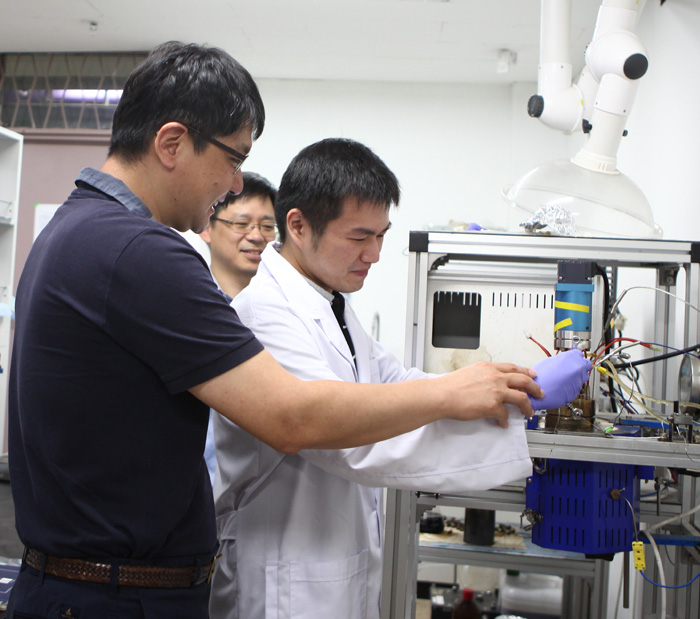
Mechanical Engineering KIM, JAEHOON Prof.
Bio-Oil Upgrading: using supercritical fluid to produce electricity and biofuels for next generation
Among various heat transfer processes for biomass that are not dealing with food resources, “fast pyrolysis” is the most famous one. This process is derived from empty palm fruit bunch, which decomposes the material for a few seconds at the temperature of 400-600°C in an oxygen free environment, which produces liquid bio-oil. However, this process has many weaknesses like; (1) low heat stability and short storage period, (2) low energy content, (3) an instability to combine with fossil fuels, (4) low pH causing corrosion of machines, (5) separation of materials if stored for a long time. Due to these weaknesses, bio-oil is not easy materials to transfer, store, and use. This research is about bio upgrading and eliminating weaknesses they have seen in the original “fast pyrolysis” process. Unlike the typical bio oil upgrading process using the usual catalyst, this research is not using a catalyst or hydrogen. Instead, they use in-situ generated hydrogen and supercritical alcohols to upgrade bio oil. And from this research, the research team was able to find that temperature and heat transfer characteristics are similar to medium grade oil. They believe the upgrade bio-oil from this process will generate green electricity and bio gasoline as well as, bio diesel for automobiles.
- No. 1
- 2018-07-04
- 2074
